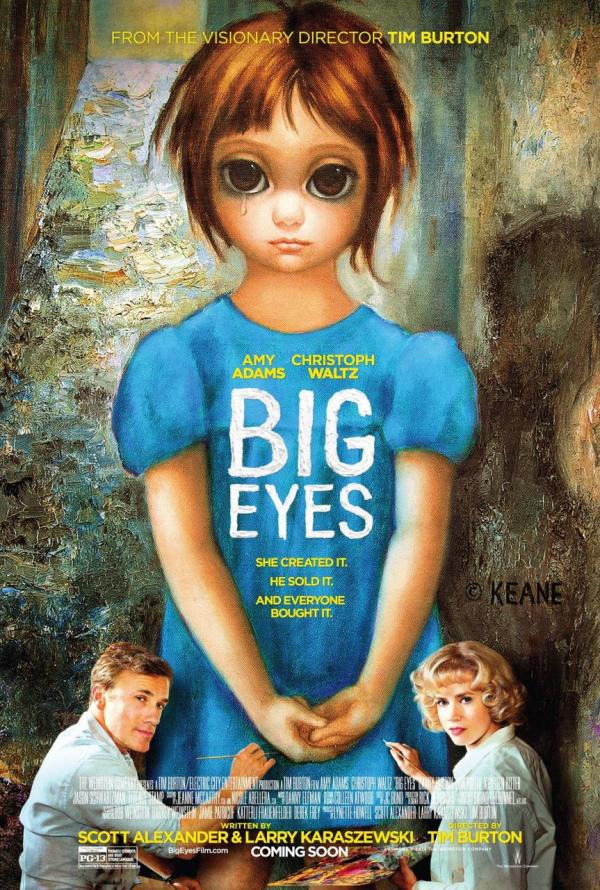BIG EYES (2014 Directed by Tim Burton; 105 minutes, U.S.)
![]() BY ZACHARY SHEVICH FILM CRITIC Big Eyes chronicles the strange but true story of the origin and rise to cultural prominence of Margaret Keane’s distinctive wide-eyed paintings and the ensuing controversy about their authorship that pitted Margaret against Walter Keane in a court of law vying for credit. Big Eyes is a stripped down, smaller budget film far more in the spirit of director Tim Burton’s early work than his more recent ventures into CGI-heavy, gaudily gothic, and, frankly, less interesting output. The film, starring Not Helena Bonham Carter and Not Johnny Depp, begins in the 1950s as Margaret leaves her first husband while a Danny Huston voiceover inelegantly informs the audience that such a move is simply “not something women did back then.”
BY ZACHARY SHEVICH FILM CRITIC Big Eyes chronicles the strange but true story of the origin and rise to cultural prominence of Margaret Keane’s distinctive wide-eyed paintings and the ensuing controversy about their authorship that pitted Margaret against Walter Keane in a court of law vying for credit. Big Eyes is a stripped down, smaller budget film far more in the spirit of director Tim Burton’s early work than his more recent ventures into CGI-heavy, gaudily gothic, and, frankly, less interesting output. The film, starring Not Helena Bonham Carter and Not Johnny Depp, begins in the 1950s as Margaret leaves her first husband while a Danny Huston voiceover inelegantly informs the audience that such a move is simply “not something women did back then.”
Relocating to San Francisco, she quickly meets and falls in love with Walter Keane, a handsome realtor and self-described “Sunday artist.” But when Walter begins to successfully sell Margaret’s work under his own name, the two begin a decades-long cover up that disguised the true talent behind the iconic paintings. For much of the film’s 104-minute run time, the story shifts between scenes of Walter taking full credit for Margaret’s work — insisting that paintings by women don’t sell — and others which illustrate Walter’s growing notoriety within the art world.
Many of these scenes are effective at illustrating how this big-eyed lie continued to be perpetuated, and why someone in Margaret’s position would allow it to happen; however, at a certain point the circular nature of these scenes becomes repetitive to the point of exhaustion. Margaret paints something new, Walter tells her women’s paintings don’t sell, and Walter receives an accolade for presenting her work as his own. Rinse and repeat. Save for the occasional minor digression, including one in which it feels as if Burton quotes Andy Warhol in order to validate his own career, the formula remains largely the same throughout Big Eyes.
Mostly gone are the kitschy stylistic ticks that have defined Burton’s career. The movie really comes alive in a scene where Margaret Keane goes shopping and the world around her takes on the pastel palette and outsize ocularity of her paintings, but any traces of that Tim Burton Feeling is limited to that moment and the generally colorful production design. For a biopic concerning an iconic expressionist painter, the execution of Big Eyes is oddly restrained. Especially for a distinctive stylist like Burton, who on paper seems an ideal match for this material but ultimately cranks out a film that looks like it could have come from any director.
That isn’t to say Big Eyes is bad, it’s just a little bland. The film is charming in stretches, contains a few laughs, and has the type of solid performance you can expect from Amy Adams. It’s not her best work, as the actress is asked to play one-note throughout, but will likely still earn Adams some Oscar hype.
The real surprise is just how out of tune and over the top Christoph Waltz’s performance is. He was recently awarded a Golden Globe nomination but either the Hollywood Foreign Press watched a different film or they’ve given him the benefit of the doubt, because in Big Eyes he is awful. Playing the role like a children’s film villain, Waltz has a transparently wide Cheshire Cat grin in nearly every scene, and when he doesn’t, he’s exploding into laughably unbelievable anger. It’s easily the worst English-language acting of his career. Whether or not it should be considered an indictment of Burton’s ability to direct actors not named Johnny Depp I will leave for others to decide.
Still, what Big Eyes lacks in originality and flair, it mostly makes up for in entertainment and a generally uplifting plot. The movie may not be the return to form longtime Burton fans hoped for, but its intriguing true-life story should still please the kind of middlebrow audiences that would have proudly hung a Keane over the sofa back in the day.

